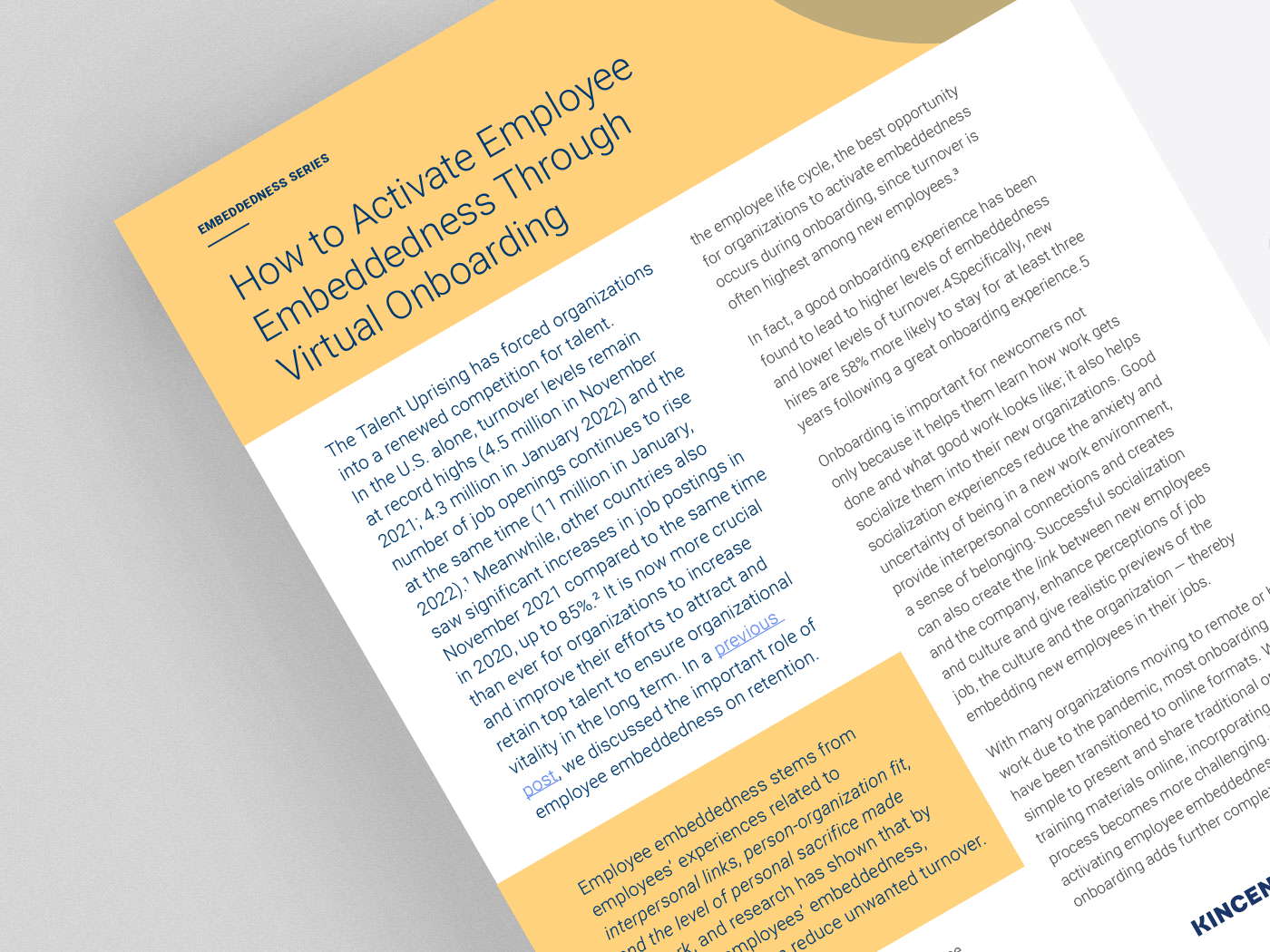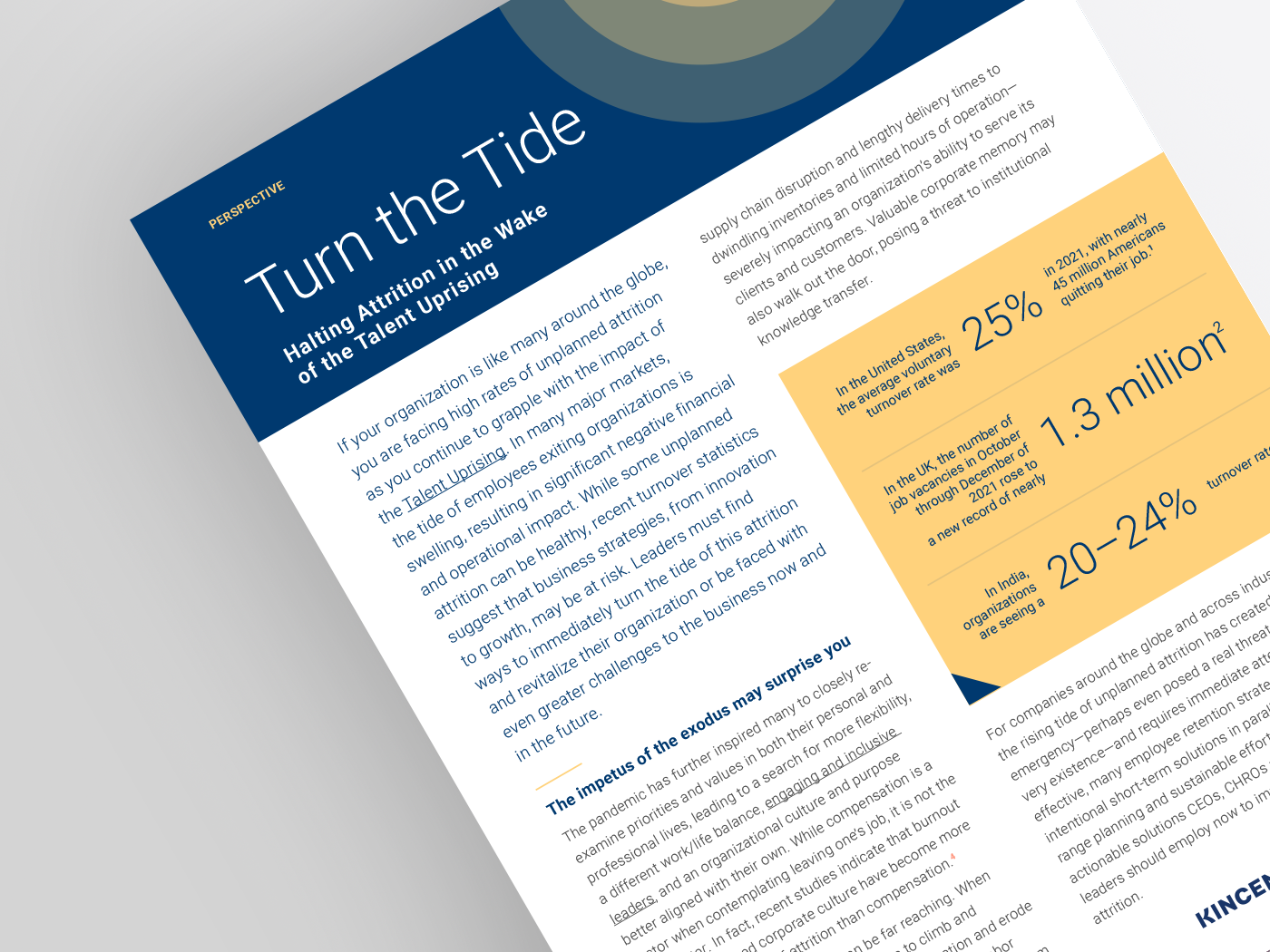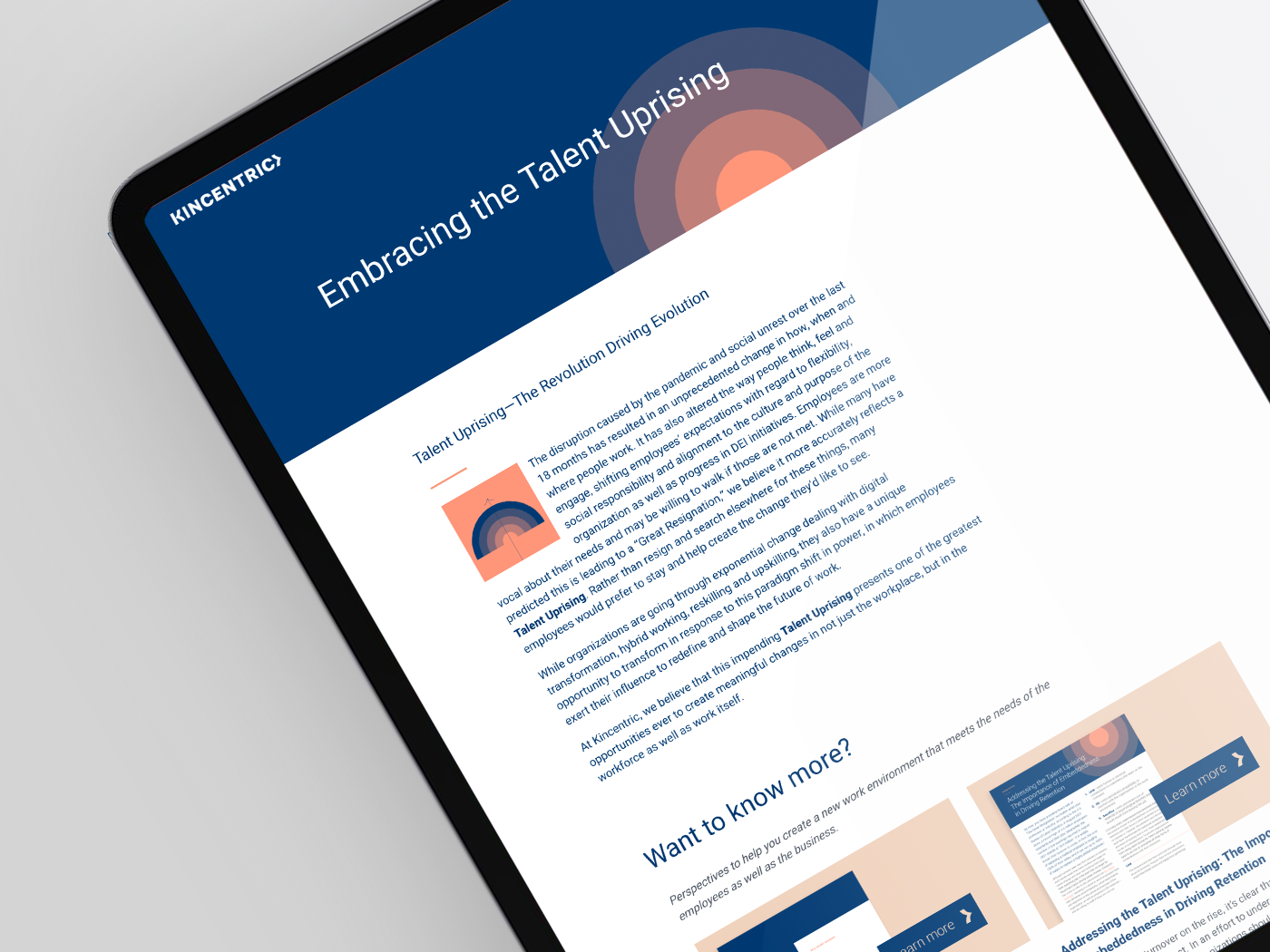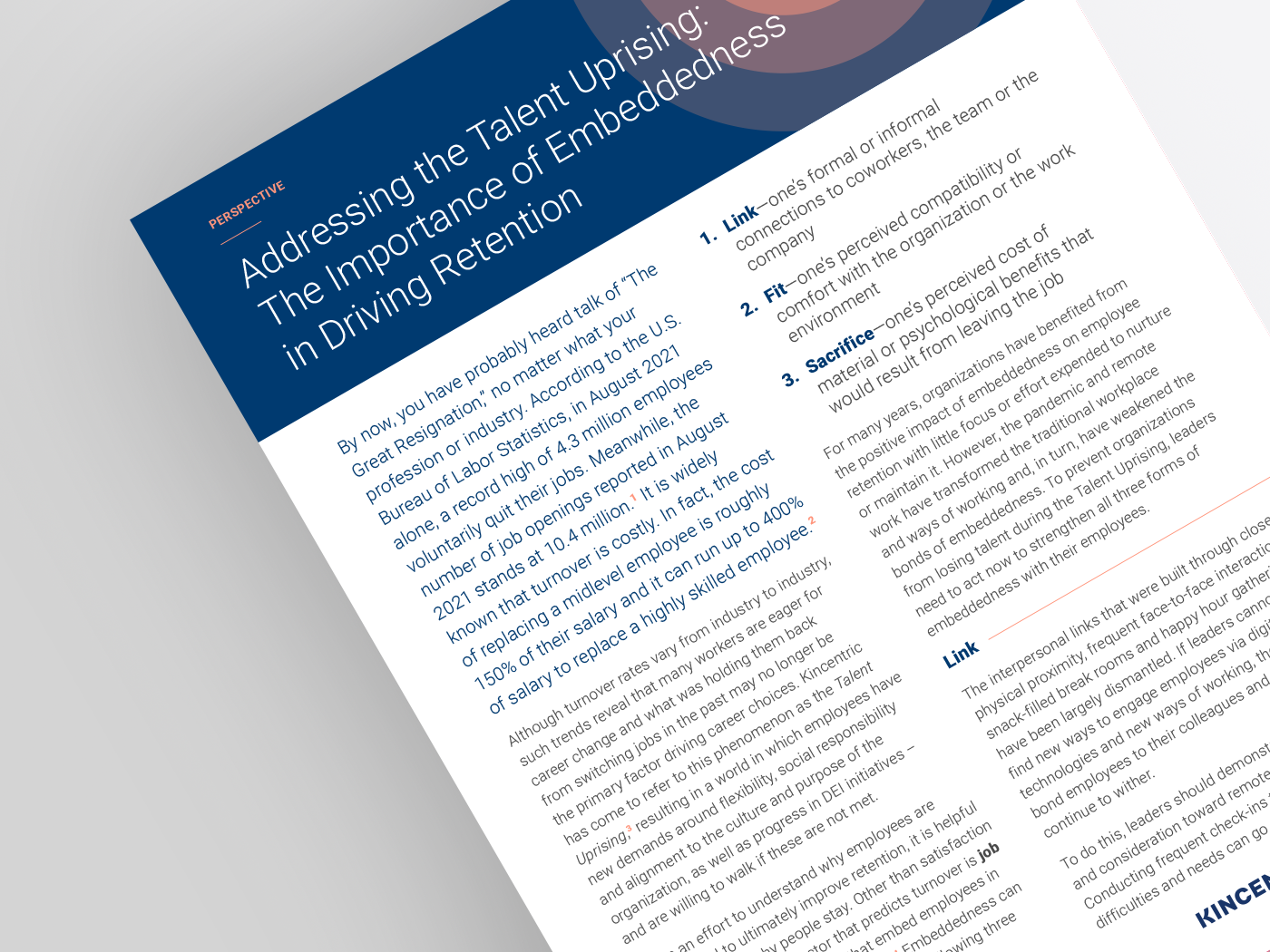
The Talent Uprising has forced organizations into a renewed competition for talent. In the U.S. alone, turnover levels remain at record highs (4.5 million in November 2021; 4.3 million in January 2022) and the number of job openings continues to rise at the same time (11 million in January, 2022).1 Meanwhile, other countries also saw significant increases in job postings in November 2021 compared to the same time in 2020, up to 85%.2 It is now more crucial than ever for organizations to increase and improve their efforts to attract and retain top talent to ensure organizational vitality in the long term. In a previous post, we discussed the important role of employee embeddedness on retention.
Employee embeddedness stems from employees’ experiences related to interpersonal links, person-organization fit, and the level of personal sacrifice made for work, and research has shown that by increasing employees’ embeddedness, organizations can reduce unwanted turnover.
While activating or strengthening employee embeddedness can happen at any point in the employee life cycle, the best opportunity for organizations to activate embeddedness occurs during onboarding, since turnover is often highest among new employees.3
In fact, a good onboarding experience has been found to lead to higher levels of embeddedness and lower levels of turnover.4 Specifically, new hires are 58% more likely to stay for at least three years following a great onboarding experience.5
Onboarding is important for newcomers not only because it helps them learn how work gets done and what good work looks like; it also helps socialize them into their new organizations. Good socialization experiences reduce the anxiety and uncertainty of being in a new work environment, provide interpersonal connections and creates a sense of belonging. Successful socialization can also create the link between new employees and the company, enhance perceptions of job and culture and give realistic previews of the job, the culture and the organization — thereby embedding new employees in their jobs.
With many organizations moving to remote or hybrid work due to the pandemic, most onboarding activities have been transitioned to online formats. While it is simple to present and share traditional onboarding training materials online, incorporating a socialization process becomes more challenging. In turn, activating employee embeddedness through virtual onboarding adds further complexity to the situation.
For new remote workers, virtual onboarding often means an endless series of video conferences learning about products, services, customers, processes, and various rules and regulations within the organization. They rarely have the opportunity to socialize with coworkers. Even when virtual onboarding includes a series of introductory one-on-one meetings with various colleagues, it is hard to build meaningful and sustainable connections beyond the introductory Zoom call.
In some cases, the newly virtually onboarded may have to contend with a lack of coworker connections, a missed sense of belonging, and feelings of being isolated, invisible and confused.6 Given that it is especially difficult to build interpersonal connections during virtual onboarding, what can be done to mitigate the barriers and activate the new employee’s embeddedness in today’s virtual world?
Let’s take a look at how to successfully embed new remote employees through the three elements of employee embeddedness.
One’s perception of fit with the organization’s culture and values starts with the job search and recruitment process and is enhanced through formal documentation and, most importantly, socialization with colleagues in the work environment.
Remote work makes it difficult for newcomers to socialize with a wide range of coworkers. In fact, remote workers tend to only communicate with a small number of coworkers relative to traditional in-person workers, thereby limiting knowledge of the company and skewing views of fit.7 Although new employees are always encouraged to ask questions or initiate connections with a wide range of fellow employees, without a clear understanding of the social norms of the organization or communication preferences of coworkers, new employees struggle with how and when to reach out.
Therefore, to activate newcomers’ perception of fit in a remote work environment, it is important to schedule both formal and informal meetings and interactions between the new employees and veterans during virtual onboarding to give them a more holistic view of the job, the organization, the procedures and — most importantly — the people. This could involve pairing the newcomer with a dedicated “onboarding buddy” or it could be arranging a series of interactions with a range of incumbent colleagues. Regardless, these initial connections can do more to help new employees bond with their coworkers and “learn the ropes” around work than official onboarding training programs.
Meanwhile, improving fit doesn’t need to focus solely on the new joiners adapting and aligning to the existing culture. Customizing the job to make it fit individual talent and personal identity can be as important as having the newcomers fit into the existing culture and norms. Encouraging newcomers to introduce their unique strengths and perspectives at the outset and giving them a stage to work on projects/tasks that best suit their talents can increase visibility while doing wonders for new joiners’ impression of the organization and setting the tone for a positive onboarding experience.8
Link is one’s sense of connection with the organization and the people. Other than learning about the organization, people and culture from official channels, one’s enduring link with the organization and its people is primarily built through informal channels. In the pre-pandemic world, this included observing how people interact with each other, initiating small talk when encountering a new colleague in the hallway, popping into someone’s office for a quick question, casual conversations over lunch or during happy hours, or a quick chat with the person sitting next to you before a meeting starts.
The lack of a physical social environment created by the move to virtual and hybrid work environments makes socialization harder because there is little opportunity for informal interactions or opportunities to observe others.
Since individual characteristics play a role in one’s approach to socialization, such that people with proactive, extroverted personalities actively take control over relationship building and seek information/feedback, it becomes especially critical for the organization to establish structured socialization schedules/programs to activate the link and enhance the fit for those with more introverted personalities. Such structured socialization efforts may help to prevent all newcomers from feeling alone, unsupported or that they don’t belong.9
Research has shown that structured socialization tactics lead to more positive job satisfaction, higher levels of commitment to the organization, better performance and lower levels of turnover compared to individual efforts to socialize.10 Therefore, to create successful virtual onboarding and a better newcomer experience, it is vital for organizations to establish formal socialization schedules and programs to assist new team members in building relationships, internalizing the culture and value of the organization, understanding the shared meanings of information within the workplace (e.g., acronyms and jargon and their meanings), etc.
These structured socialization schedules can include casual get-togethers or virtual coffee time with no work agenda, having people share recent stories (e.g., new hobbies, life changes, personal achievements) during the first few minutes of a team meeting, or virtual team building activities featuring virtual escape rooms, team charades or fun competitions with small rewards. Finding ways to be creative and have fun together is key to building connections and establishing the embeddedness link.
HR (e.g., HRBPs, Talent Acquisition leaders, Learning and Development leaders) is likely to play an important role in strategizing, planning and executing onboarding programs. Because of that, some see onboarding as HR’s responsibility. However, with reduced face-to-face time with new employees, it is difficult for HR alone to create the fit and link necessary for successfully embedding new joiners, not to mention to understand what new employees have to sacrifice in order to work in the organization or what difficulties they are facing at work. In turn, there is little basis for developing strategies to help them overcome such barriers.
Thus, to activate employee embeddedness through virtual onboarding, the hiring manager or the direct supervisor needs to commit to a high level of involvement and open communication in the onboarding process, preferably through regular one-on-one meetings during the early stages of onboarding. By offering opportunities for leaders (or the hiring managers) to understand new employees’ needs, concerns and problems, they can ensure the newcomers have sufficient knowledge, skills and resources to excel at their work. Leaders should take time to get to know their new hires on a personal level before diving into how they feel about the new position and new work environment.
As mentioned earlier, it is essential to structure these interactions by building such leader-member meetings into the official onboarding schedule. These interactions should not be expected to be spontaneous or left up to the employees.
Moreover, the use of brief pulse surveys at targeted points in the onboarding process can help to identify and address any challenges the newcomers may run into or any opportunities to improve the process and further reduce early-stage turnover. These pulse surveys can be administered during major milestones (e.g., 1st month, 3rd month, 6th month, etc.) to gauge the impact of the onboarding on embeddedness. Alternatively, conducting a newcomer 360-degree survey around the three-month mark could help newcomers gain insight into their performance and their interactions with others.
Remember that the onboarding process is longer than just the first two weeks on the job. Onboarding may continue informally as employees engage in work and gather insights into the culture, values, norms and processes of the organization. However, designing and implementing a more structured virtual onboarding process that extends for at least three months will help ensure newcomers are getting accurate information, robust opportunities for socialization and timely feedback — all of which can help to maximize their embeddedness from the outset.
1. U.S. Bureau of Labor Statistics. (2021, November 12). Job openings and labor turnover summary. Retrieved from here.
2. Gartner Inc. (December 2021). Monthly job, skill, and occupation demand trends. Retrieved from here.
3. Allen, D.G. (2006). Do organizational socialization tactics influence newcomer embeddedness and turnover? Journal of Management, 32, 237–256.
4. Ibid.
5. Farren, C. (2007). Help new hires succeed: Beat the statistics. [White paper]. Retrieved from here.
6. Petersen, A.H., & Warzel, C. (November 22, 2021). Remote work is failing young employees. The New York Times. Retrieved from here.
7. Ahuja, M.K., & Galvin, J.E. (2003). Socialization in virtual groups. Journal of Management, 29, 161–185.
8. Cable, D.M., Gino, F., & Staats, B.R. (2013). Breaking them in or eliciting their best? Reframing socialization around newcomers’ authentic self-expression. Administrative Science Quarterly, 58, 1–36.
9. Bauer, T.N., & Erdogan, B. (2011). Organizational socialization: The effective onboarding of new employees. In S. Zedeck (Ed.), APA handbook of industrial and organizational psychology, Vol. 3. Maintaining, expanding, and contracting the organization (pp. 51–64). American Psychological Association.
10. Bauer, T.N., Bodner, T., Erdogan, B., Truxillo, D.M., & Tucker, J.S. (2007). Newcomer adjustment during organizational socialization: a meta-analytic review of antecedents, outcomes, and methods. Journal of Applied Psychology, 9, 707–721.


Learn how to create a new work environment that meets the needs of both employees and the business.

Want the latest insights delivered straight to your mailbox?